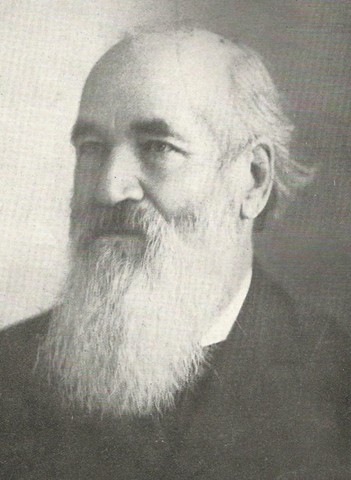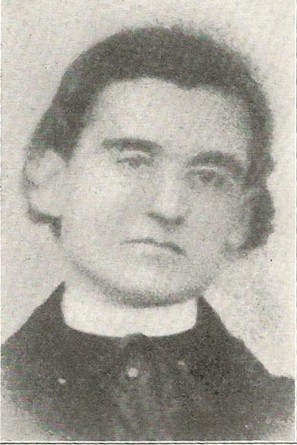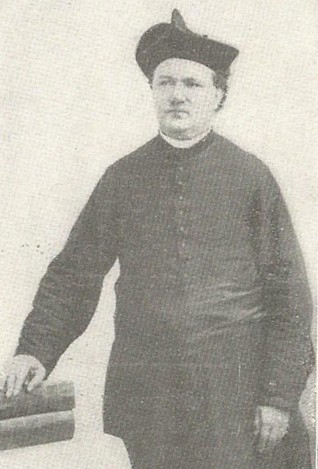p.24
 Father Laurent Golden Jubilee 1901 |
p.25
“ My friend, I send you to Muscatine for a month, and afterwards I will see.” Bishop Loras was speaking to a young man only recently ordained to the priesthood- the Reverend Philip Laurent. And the “month” lasted fifty-one years; from 1851 to 1902 Father Laurent was pastor if St. Matthias.
For many men it is a comparatively easy accomplishment to win respect and good will in a community. But to retain and intensify them through a half-century period is, by no means, an experience in the realm of the ordinary. Yet, that precisely was Father Laurent’s glory. Even a casual acquaintance with the parishioners of St. Matthias in his time is ample to reassure one of the clinging affection with which he is still cherished. Father Laurent’s name is a hallowed one in St. Matthias’ today, and it is, to use a trite phrase, a household word. As the embodiment of the ideal parish priest, Father Laurent is here accepted- it is almost an article of faith.
Only rarely does the Catholic priest secure a genuine place in the affections of a community at large in the way Father Laurent did. The non-Catholics held him veneration; apparently nothing less than that. Regarding his wholesome influence on the community, Muscatine’s most respected men have given, on numerous occasions, their unequivocal testimony. In 1902 when a memorial edition of the News Tribune was published, there was no dearth of able men to pay tribute to Father Laurent. The Hon. G. M. Titus, Frank Neidig, F. M Witter (who was superintendent of schools), J Scott Richman, Col. J.B. Dougherty, and Hon. I. B. Richman were among those whose sentiments of appreciation appeared in public print. Nor do we have to wait so long for tributes to him. During the night of January 28, 1888, St. Matthias’ school was consumed by flames. The work of twenty-five years had to be done over again. “ The Father asked for help, and had not to ask twice. Benjamin Hershey began the subscription with $500, and many gave their $100 each, while hun- …
p.26
… dreds of others wanted to join in the good work. They all considered it a slight not to be called upon.” By the refined Father Laurent all of this was genuinely appreciated. “God Bless you all, generous Muscatine friends. If sometime the souvenir of lovely France, of dear old relatives and companions across the briny deep, bring an instant of regret to the willing exile, your noble hearts and generosity soon dispel gloomy thoughts and proclaim that this is the land of Iowa- it is good to be here.” Our previous statement in this sketch is a true one: “ that our Catholic people never did feel that they were the adherents of the old religion, moving silently and sorrowfully about, as memorials of what had been.” Father Laurent made it so.
It is to be regretted that we cannot linger reverently and lovingly over the details of this good man’s life. However, a generous part of other sections in this sketch have related the various developments in the parish. Father Laurent’s part- the chief directing and motivating force in them- has not been slighted. In this place, then, in rapid survey the salient facts in his life history will be narrated.
Philip Laurent was born near Dijon, France, on the twenty-second day of February, 1828. He was the ninth of eleven children. Rather early in his life there must have been manifestation of a priestly vocation, for we find him in the little preparatory seminary of Plombieres, close by Dijon. Then he attended school in the old city of Autun. His philosophical studies were completed at Troyes, and his degrees taken in the celebrated institution of Paris, the Sorbonne. Not as yet had he decided on going to America. He was then twenty years of age; the year was 1848- that of revolutions in Europe. In such a time the deep things of a man’s soul are stirred. This was true of Philip Laurent. A schoolmate of Bishop Loras, Father Bernard, had spoken to him of the American call. “He depicted to him in glowing terms the greatness of the work done by Bishop Loras among the Indian tribes and in the settlements of the new Territory in Iowa.” To divine God’s wishes regarding his vocation, Philip Laurent retired to a monastery in Einsiedeln, Switzerland, for a few …
p.27
In April, 1850, while as yet a sub-deacon, he, with four other young men- Andrew Trevis, Frederick Jean, Michael Lynch, and Matthias Michels- sailed for their adopted country. From New York to Albany by steamer, thence to Buffalo by rail they traveled. To avoid the stage coach the journey to Milwaukee was made by way of the lakes. Partly in lumbering wagons and partly on foot they wended the rest of the way to Dubuque. Not long did he remain there, for early in 1851 he was completing his theological studies in Perryville, Missouri, in St. Mary’s Seminary. The glorious day of his ordination was November 8, 1851. In Dubuque and by Bishop Loras his priestly powers were given him. “His first Mass was said in a little chapel, cold and deserted, where he could hear the grunting of hogs instead of the beautiful choir as is generally the case.” Before the consecrated oil on his fingers had dried, Father Laurent was appointed pastor of St. Matthias’, Muscatine.
The great work done by him during his fifty-one year pastorate here has been sketched in other sections already. Here emphasis might be laid on the work and journeys that carried him beyond his parish.
The western part of Iowa was not settled as early as the Mississippi fringe of Iowa. To the Council Bluffs …
p.28
… region in May, 1854, Father Laurent went, accompanied by his bishop, Mathias Loras. He was chosen to make the beginnings of new parishes in that region. Although he worked there only a few months, some of his experiments have come down to us. “Riding his little pony and carrying with him an alter, vestments and other necessary articles for the Holy Sacrifice, he would seek out the scattered Catholics and give them the long-looked-for sacraments. In some one of those pioneer homes he would remain during the night as his ministrations sometimes kept him in a settlement for a couple of days. When there was no Catholic farmer to be found and when night was falling on the prairie, he would have to ask hospitality of the Protestants. Sometimes very willingly they would take him; at other times, very reluctantly. Once or twice he was so poorly received (they knew him to be a priest) as to not be given shelter. Since they could not refuse it to his faithful pony, he would stay in the stable for the night.”
Towards the end of that year, 1854, Father Laurent became a professor at Mount St. Bernard’s Seminary, four miles from Dubuque. “Beautiful old Mound,” he wrote many years later, “so loved by its founder, Bishop Loras, abode of peace, so quiet and romantic and so adapted for study and meditation! When will better days dawn upon thee!” Not long did Father Laurent remain at Mount St. Bernard’s as professor of philosophy and Church history; early in 1855 he was chaplain to the Visitation Sisters in Keokuk, Iowa. Sometime in July of the same year St. Matthias parish celebrated his joyous return-this time to remain as pastor until 1902.
There were three other times when Father Laurent was taken away from Muscatine. In 1857, 1861-1862, and 1885 visits to that old country he never could quite forget were made. The one in 1885 was with Bishop Henry Cosgrove, second bishop of the Diocese of Davenport. Father Laurent accompanied him to help make the official report on the condition of the diocese. In France, his niece, Miss Theresa Laurent, joined him and came to America. In passing, it should be remarked that a grateful people still appreciates the fine service she rendered them and their …
p.29
… pastor, Father Laurent. Interested in all things about the Church- adorning the altars, and directing the choir especially- she brought to the Sacred mysteries the little touches of French piety.
On November 8, 1901, the Golden Jubilee- fifty years in the priesthood- was happily celebrated by this pioneer and his parish; rather we should say, by all Muscatine. As was noted at he beginning of this sketch, Father Laurent came to have a secure place in the affections of the Muscatine people. Here are Irving B. Richman’s words: “It was a genuine delight to meet the good Father on our streets. He was so brisk, so cordial, so abounding in good will.”
It was apparent to Father Laurent’s friends in 1902 that his constitution was breaking, that the sad end was not far off, The Hon. G. M. Titus gave expression to that feeling: “ I wish Father Laurent might have known with what sincere sorrow his many friends in Muscatine beheld his rapid decline of the last two years. Inch by inch we witnessed the shortening of his pace while walking; the erect form became bent; the keen and watchful eye became dulled, and, we said to ourselves, the uneven journey of life is soon to end for our friend.” Shortly before leaving for France, Father Laurent suffered a serious sick spell. During it, quite naturally, to the land of his birth and the dear ones there, his thoughts turned. He told his niece “he heard the bells of the great churches of Dijon ringing their majestic chimes and that they summoned him to France.” That summons he obeyed and with the very shadow of these Churches familiar to him from youth- St. Benigna’s, Notre Dame, and St. Michael’s- that his soul winged its flight to God. His death occurred on December 2, 1902, just two weeks after his landing.
The name Father Laurent and his life and works will not be forgotten in Muscatine. They will live in the affectionate regard of all who can appreciate one of God’s noblemen. Immortality in heaven’s court is his, we are sure. A certain immortality on earth has come to him in …
p.30
… the warm affection, destined not to die, of his parish. Father Laurent heard the bells of old France sweetly urging him to return to the land of his first love. But what of his own chimes in the tower of St. Matthias’? “Strike on, O clock! Through the long watch of the day and night your pure tones note each passing hour. You stand as a monument- among other monuments-to mark the place where our departed friend for so many years so eloquently pleaded his Master’s case.” It was the wish of all that …
 Father Peter Magne |
… the chimes of the approaching Christmas could have summoned their departed pastor to worship. Their other wish- and it still persists in many hearts- was that his blessed remains could have rested in that beautiful “God’s Acre” whose creator he was and whose plan his hands had drawn. If only his chimes could be faintly heard there, they would have wished to kneel in …
… thoughtful prayer for him, and to take from his grave a little clod of earth as an earnest of his blessing up them, their families, and their homes.
p.31
During the long tenure of Father Laurent at St. Matthias’ several priests served here for relatively short periods. Fathers Magne, Kinsella, and Kempker were here during Father Laurent’s visits in France.
In 1857 the Reverend Peter Magne, a priest much loved by this parish, was in charge here. Before ordination he was a Brother of the Sacred Heart. In religion he was Brother Jubin, Father Trevis’ home near St Marguerite’s, Davenport was his seminary and Father Trevis prepared him for ordination. He was ordained at Mount St. Bernard’s, near Dubuque. While on a journey between Washington and Mount Pleasant in 1859 he met a sudden death. He was drowned in Crooked Creek. A grateful people brought back to Muscatine his remains. On a stone erected over his grave in St. Mary’s Cemetery is this inscription: “Rev. Peter Magne, born at La Chaise Dieu, France. Drowned in Crooked Creek, June 29,1859, aged 30 years. Buried at Richmond, his remains were transferred here by the faithful of Muscatine, who for two years have loved him much.”
While Father Laurent was in the Council Bluffs district, Mount St. Bernard’s, and Keokuk, Father J.M. Flammang cared for the interests of St. Mathias’. That was in 1854
During 1861-1862 the Rev. Michael Kinsella was appointed pastor. In another section of this sketch his activities have been mentioned.
From October, 1885, until May, 1886, the Reverend John F. Kempher did relief service here. Bishop Crosgrove, accompanied and helped by Father Laurent, made his official “ad limina” visit to the Holy Father at that time.
The Reverend Matthias Hammon, and uncle of the present pastor, was here at least on one Sunday in the early days. With Father William Emonds, long –time pastor of St. Mary’s, Iowa City, he was ordained in 1852. We are …
p.32
… in possession of some of his historical letters. Muscatine is not mentioned in them.
 Father J. M. Flammang |
… Graveyard of Muscatine, Patrick McCormick, John Ovens, Sophia Mary Berry, … Farrell, and a child dead without baptism, and Anna Keenan.”
In 1862 the Archbishop of Paris offered Father Laurent the rectorship of La Madeleine Church of Paris. Had he accepted, he would have cared for the English speaking Catholics there. St Matthias Parish still appreciates the rejection of the offer.
p.33
St. Mary’s Cemetery is the work of Father Laurent, The tracing of roadways and lots was done by him. Never have we seen a better appearing cemetery in the Middle West.
We are told that Father Laurent had the first had first greenhouse in the history of Muscatine. It was the admiration of everyone.
In 1856, soon after the St. Matthias Church was built, the grading of Eighth Street was begun. Holding his sloping property from tumbling into the street below was a real task. When storms raged during the night Father Laurent often would have to leave his bed, go to the front of the property, drive pegs in the sods, and so prevent the washing down of the slope. Today the long terraced slope in front of St. Matthias Church looks so natural that one would never suspect the creative and saving work of Father Laurent years and years ago.
About five years before his death Father Laurent deeded over his rectory and the ground near it to his parish. An elder sister of his, residing in France, had contributed much to this property. Fearing that the parish would have to pay too much money in order to redeem it from his relatives, the good priest did the generous thing.